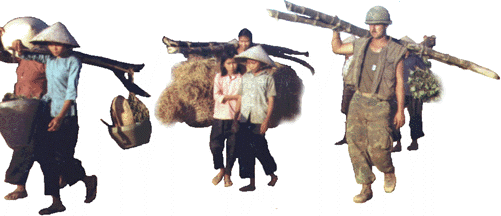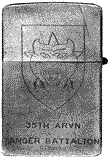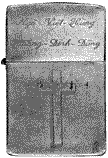Brought up in a culture of wealth and plenty, it was sometimes difficult
to put things into perspective in a different, more primitive society. In America,
farm implements included tractors, plows, and other mechanized devices. In Vietnam
they used a water buffalo and a couple pieces of wood. To us, a kitchen had running
water, an oven, a refrigerator, and cupboards full of dishes, pots and pans. To the
Vietnamese in the countryside, a kitchen was a corner of the mud hootch with an open fire
on the floor.
We stumbled onto the garment district in a very accidental sort of way. Our day
began with a heliborne into a village on the outskirts of the Ho Bo Woods. No
village this close to an enemy stronghold could be considered friendly. The last
units into this area had taken casualties in a mortar attack, so we came in expecting
trouble. Our formation swept in just outside the village to gain the element of
surprise. We jumped to the ground as the choppers slowed to a hover, and then they
lifted forward without touching down, and were away in less than a minute. We spread
out quickly and started for the village to take up covering positions for the second lift.
Within minutes, the rest of the company arrived and moved toward the village.
They reached us just as a volley of mortar rounds exploded where the choppers had
been.
Covering gunships were on station and swung around to fire into the forest beyond the
village. We had no more trouble with mortars for the rest of that day! Then we
moved in to search the village. There were only six or seven hootches,
the typical mud huts with thatched roofs.
The captain was expecting results and we were instructed to be thorough. Each of
the hootches received a careful examination. The hootches
themselves contained little - a few beat up cooking vessels and utensils, a handful of
clothes. The people living in such areas as this usually had little wealth.
Most of the villagers left when the Vietnamese government relocated the inhabitants to
safer areas. We could be fairly certain that those who remained were supporting the
enemy.
Two of the hootches had ancient Singer pedal-operated sewing machines. It had
been years since I'd seen models like these - and then only in antique shops. They
were worn out and rusty, but still working. The thought occurred to me that for the
villagers this was high-tech state-of-the-art equipment compared to what they had probably
used for centuries. In America, we used machines such as these only for decoration.
Our two cultures were worlds apart.
Completing the interior search, we took thin sticks and poked around the base of each
hootch. Suddenly one GI hit something hard with his stick. Carefully we dug
into the loose soil. The lid of a .50 cal. ammo can appeared. Inside we found
a pistol and several handfuls of ammo.
Spurred on by this discovery, we searched and probed the area again, but by noon we had
found nothing else. The captain called a lunch break. We moved to a grassy
area beyond the village and sat on the ground to eat our C's. No one moved around
much for fear of booby traps.
As we sat eating a yell went up nearby - one man had noticed something lying in the
grass behind him. It was a wooden frame - a trapdoor entrance someone was just
building. The device was about ten-inches wide and fifteen-inches long. Inside
the wooden frame a single board was hinged with a piece of heavy wire. That was the
trap door itself. The door had a five-inch box on top of it to be used as a
"planter". Charlie would fit the door over a tunnel opening, fill the box with
dirt and seed, and in a few weeks it would be completely hidden by the new grass. It
would be invisible. Then we would have found it only by standing right on top of it.
And so small! I couldn't have put one of my legs through it at the thigh, let
alone my hips! Trap doors suggested tunnels. Perhaps
we had been looking in the wrong places. Our search began again.
In a matter of minutes we made a new discovery when one GI fell into a hole. As
he climbed out, we saw a 55 gal. drum buried in the ground. It was filled with
cloth! We emptied the drum, and counted hundreds of cut or sewn sets of clothing -
what we called "pajamas". Most rural Vietnamese wore these two piece suits
of thin cotton cloth. The pants were like pajama-bottoms with an elastic waist or a
drawstring. The tops either opened at the front with a row of buttons, or were made
in a pullover version.

 Soon we found a second drum. In all we had more than five hundred sets
of clothes - this village was actually an enemy supply depot. Here, North Vietnamese
soldiers traveling south to Saigon could change from their old, worn uniforms into new
clothes, and at the same time camouflage themselves to look just like every other
Viet. Enemy units were obviously moving through here in force. The irony of it
all! To us a supply depot consisted of warehouses, large supplies of crates and
boxes, big trucks, clerks and perhaps computer systems to keep track of everything.
To our Vietnamese enemy, a supply depot was two metal drums buried in the earth - and two
very old Singer sewing machines.
Soon we found a second drum. In all we had more than five hundred sets
of clothes - this village was actually an enemy supply depot. Here, North Vietnamese
soldiers traveling south to Saigon could change from their old, worn uniforms into new
clothes, and at the same time camouflage themselves to look just like every other
Viet. Enemy units were obviously moving through here in force. The irony of it
all! To us a supply depot consisted of warehouses, large supplies of crates and
boxes, big trucks, clerks and perhaps computer systems to keep track of everything.
To our Vietnamese enemy, a supply depot was two metal drums buried in the earth - and two
very old Singer sewing machines.
We destroyed the sewing machines and tore up the gardens. Then out came the
cigarette lighters to torch the roofs. The bales of captured uniforms were sent
ahead to battalion HQ to be redistributed in the village of Cu Chi. For us it was a
successful day. The garment district had made its last sale.
